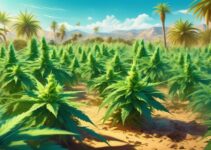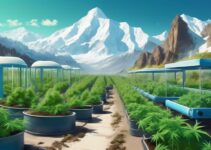You've probably heard that creating the ideal climate for cannabis seeds is a key factor in their successful growth. But what exactly does that entail? From temperature control to humidity levels, there are several crucial elements to consider when it comes to providing the perfect environment for your cannabis seeds to thrive. In this discussion, we'll explore eight essential tips to help you create the optimal climate for your cannabis seeds, ensuring their healthy development and maximizing your yield.
Key Takeaways
- Maintaining a consistent temperature range of 70-85°F (21-29°C) during the day and 58-70°F (14-21°C) at night is crucial for the healthy development of cannabis seeds.
- Fluctuations outside the recommended temperature range can negatively impact seed development and overall seed maturation.
- Regular monitoring and adjusting of temperature and humidity levels in the grow room are vital for optimal growth and yield.
- Environmental factors such as humidity, air circulation, and controlling temperature during seedling growth play a significant role in ensuring healthy growth and development of cannabis seeds.
Optimal Temperature Range for Cannabis Seeds
Maintain an optimal temperature range of 70-85°F (21-29°C) during the day and cooler nighttime temperatures between 58-70°F (14-21°C) to promote healthy growth of cannabis seeds. Cannabis seeds thrive in these conditions, ensuring optimal growth and maximum yields. It's important to note that slight temperature variations can stimulate specific growth properties in cannabis plants, so keeping the temperature within this range is crucial.
Consistency in temperature is key. Fluctuations outside of the recommended range can negatively impact the development of cannabis seeds. By providing the ideal climate, you create the perfect environment for cannabis seeds to flourish.
Furthermore, the overall climate plays a significant role in the maturation of cannabis seeds. Maintaining relative humidity between 40-60% is crucial for the healthy growth of the seeds. When paired with the optimal temperature range, the climate provides the perfect conditions for cannabis seeds to thrive.
Monitoring and Adjusting Grow Room Temperature
To ensure optimal growth and health of your cannabis seeds, closely monitor and adjust the temperature in your grow room using a digital thermometer and hygrometer with a memory feature. Maintaining ideal growing conditions involves controlling both temperature and humidity levels. For temperature, the ideal range varies depending on the growth stage of the cannabis plants. Generally, temperatures between 70-85°F (21-29°C) are suitable for most growth stages. LED grow lights can influence the temperature in the grow room, so it's essential to consider their impact. Additionally, Relative humidity (RH) plays a crucial role in the overall climate control of the growing environment. Regular monitoring and adjusting of these environmental conditions are vital to ensure that the temperature and humidity levels remain within the optimal range. Innovative methods like using wireless monitoring solutions can streamline the process of climate control, allowing for efficient and precise adjustments. By carefully monitoring and adjusting the temperature and humidity levels in your grow room, you can create the ideal environment for your cannabis seeds to thrive.
Impact of Hot and Cold Temperatures on Cannabis Seeds
Experiencing extreme heat or cold can significantly impact the growth and development of cannabis seeds, potentially leading to stress and compromised quality. Temperature plays a crucial role in the cultivation of healthy cannabis plants, especially when growing cannabis outdoors. High temperatures can slow down the growth process, resulting in heat stress and reduced potency. Additionally, during the flowering stage, high temperatures can lead to stunted growth and smaller buds. On the other hand, cold temperatures can also have adverse effects, causing slow growth and cold stress for cannabis seeds.
To better understand the impact of temperatures on cannabis seeds, it's essential to consider the ideal temperature and humidity ranges. Maintaining stable temperature ranges is crucial for the healthy growth and yield of cannabis plants. Environmental factors such as humidity and air circulation also play a significant role in mitigating the impact of hot and cold temperatures. Monitoring and adjusting these factors help ensure healthy growth and high-quality buds for cannabis seeds.
| Environmental Factors | Impact on Cannabis Seeds |
|---|---|
| High Temperatures | Heat stress, reduced potency |
| Cold Temperatures | Slow growth, cold stress |
| Ideal Temperature and Humidity Ranges | Healthy growth and yield |
| Monitoring and Adjusting | Ensuring high-quality buds |
| Humidity and Air Circulation | Mitigating temperature impact |
Controlling Temperature for Seedling Growth
Controlling the temperature during seedling growth is crucial for ensuring optimal conditions and healthy development of cannabis plants. Maintaining a temperature between 74-78°F (23-26°C) is ideal for seedling growth. Here's how you can control the temperature effectively during this stage:
- Use a digital thermometer and hygrometer with a memory feature to monitor humidity and temperature levels.
- Adjust temperature and humidity levels for different growth stages: seedling, vegetation, and flowering.
- To lower humidity and temperature, increase fresh, cool air, water plants when lights are on, and add a dehumidifier.
- To increase humidity and temperature, keep the soil moist, use a humidifier, and surround the room with moist towels and open water containers.
Regional Climate Considerations for Cannabis Seedlings
When considering regional climate factors for cannabis seedlings, it is essential to understand the ideal environmental conditions that promote their healthy growth and development. The temperature range plays a crucial role in the success of outdoor growers. Cannabis seedlings thrive in regions with warm to hot summers and mild fall weather, similar to the Mediterranean climate. In areas with more rain and lower temperatures, the choices of cannabis strains become limited, making indoor gardens or greenhouses viable alternatives. Nighttime temperatures are also important, as they should not drop too low. Humidity levels and natural sunlight are other critical factors to consider. Different stages of growth require specific humidity levels and natural sunlight exposure. Furthermore, the regional climate can affect the pH level of the soil, influencing the plant's nutrient uptake. For regions with less sunlight, LED lights can be used to supplement natural light. Overall, understanding the regional climate and its impact on cannabis cultivation is essential for successful seedling growth.
Frequently Asked Questions
What Is the Best Environment for Cannabis Seeds?
To cultivate thriving cannabis seeds, ensure optimal humidity levels, light exposure, soil quality, air circulation, nutrient availability, watering frequency, pest control, and pH balance. Master the germination process in a suitable growing medium for successful growth.
What Temperature Is Good for Cannabis Seed?
To ensure optimal germination and seedling care, control temperature between 70-85°F during lights-on and 58-70°F during dark periods. This regulates growing conditions, prevents heat stress, and enhances cold tolerance. Climate adjustments are crucial for seed viability and temperature regulation.
Is 80 Degrees Too Hot for Cannabis?
80 degrees can cause heat stress in cannabis, affecting plant hydration, nutrient absorption, and thermal regulation. For optimal temperature control, aim for 70-75 degrees. Indoor cultivation requires precise climate management. Outdoor germination may lead to leaf discoloration and slow growth.
Is 65 Degrees Too Cold for Cannabis?
65 degrees is too cold for ideal temperature during seed germination and seedling growth. Cold stress can hinder root development and cause temperature fluctuations. Cold weather negatively impacts plant growth. Proper temperature regulation is crucial for environmental impact.





